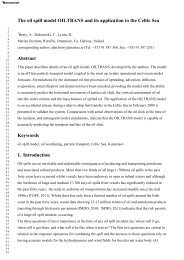PRESSING SEAWEED & ARTWORK
PRESSING SEAWEED & ARTWORK
PRESSING SEAWEED & ARTWORK
You also want an ePaper? Increase the reach of your titles
YUMPU automatically turns print PDFs into web optimized ePapers that Google loves.
Explorer Education Programme<br />
Lesson Plan: Pressing Seaweed & Artwork<br />
Method:<br />
1. Select a piece of seaweed and wash it in (fresh?) water.<br />
2. Put the seaweed into a basin filled with (fresh?) water. It is a good idea to float<br />
the seaweed in the water until it opens up fully.<br />
3. Slip the A4 sheet of paper in the water underneath the seaweed.<br />
4. While still submerged, arrange the seaweed with the paint brush so as all the<br />
parts are visible.<br />
5. When you are satisfied with the presentation of the seaweed pull the sheet from<br />
the top out of the water, the seaweed should secure itself to the sheet. Seaweed has<br />
a natural gelatinous coating that acts like a glue.<br />
6. Tip the paper to drain off the water. Once you lift the paper, make sure you don't<br />
disturb the seaweed.<br />
7. Place the wet paper and seaweed on newsprint.<br />
8. Place a sheet of the nappy liners / absorbent paper over the seaweed.<br />
9. Press the plant between newsprint and weigh it down with a heavy object e.g.<br />
books. To help the seaweed dry out quickly and prevent it going mouldy, replace the<br />
dry newspaper sheets every one to three days.<br />
10. Leave pressing for at least 10 days until the seaweed is dry.<br />
11. When the seaweed is dry, label the page that the seaweed is stuck on with the<br />
following information:<br />
o the date it was collected<br />
o the location where it was found<br />
o type of seaweed it is<br />
o Label the holdfast, blade, and stipe on your seaweed.<br />
12. Compare the differences/similarities with a common land plant.<br />
13. When you have pressed a number of different type of seaweeds, combine the<br />
pages to make a book. Place a coloured sheet of paper at the front and the back of<br />
the collection. Punch a hole through pile of sheets and tie together with a piece of<br />
string/ribbon. The cover can be decorated using a seaweed theme and should<br />
include a title, the student’s name, class and date the book was produced.<br />
For marine related lesson plans, worksheets and activities see<br />
www.marine.ie

















